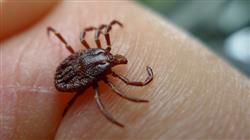Be Prepared for Ticks this Summer

Indiana certainly has its fair share of summer pests, most of which are simply an annoyance rather than actually being harmful. However, due to their reputation for spreading disease to humans and being a potentially harmful nuisance for pets and livestock, ticks are one pest that should not be ignored this time of year. Ticks are a common presence, particularly in wooded and highly vegetated areas. Thankfully, there are a few steps that can be taken to help prevent the likelihood that you or your pet will be a host for this parasite.
In keeping an eye out for ticks, it is helpful to know what to look for. Ticks are wingless and have a single, oval body that is relatively flat (unless it is filled with blood). Adults and nymphs have eight legs, while larvae have only six legs. The “head” of a tick consists of a pair of leg like sensors known as “palps” that enable the tick to detect an approaching host, as well as a pair of knife like structures known as “chelicerae” that cut an opening in the hosts skin, and a single barbed structure known as a “hypostome” that becomes anchored in the hosts flesh as it begins to take blood.
Tick infested areas, such as woods or areas with high grass, should be avoided as much as possible. If you do enter these areas during the summer, stay on established trails as much as possible, and wear light-colored clothing, long pants, and a long sleeve shirt. Shirts should be tucked in, with socks pulled over the pant cuffs. Insect repellents containing diethyl toluamide (DEET) or permethrin may be applied to shoes, socks, and pants. Check yourself, children and pets frequently, especially in areas with exposed skin as well as around the head, groin, and underarm area. If a tick is found, use blunt forceps or tweezers to grasp the tick as close to the skin as possible and pull upward with steady, even pressure being careful not to squeeze or crush the tick. After removal, disinfect the bite site and wash hands thoroughly with soap and water. If a rash or flu-like symptoms develop, consult a physician immediately.
There are a few preventative measures to limit tick population, primarily by eliminating unnecessary vegetation around yards and property and along wood edges. Residual insecticides can be applied along trafficked areas to help mitigate ticks from congregating; however it is not necessary to treat maintained lawns and not usually feasible to treat larger areas such as woods. When applying insecticides, always follow label directions and keep children and pets off the area until dry. For more information on ticks, including different types of ticks, refer to Purdue’s public health publication on ticks available here: https://extension.entm.purdue.edu/publications/E-71.pdf

